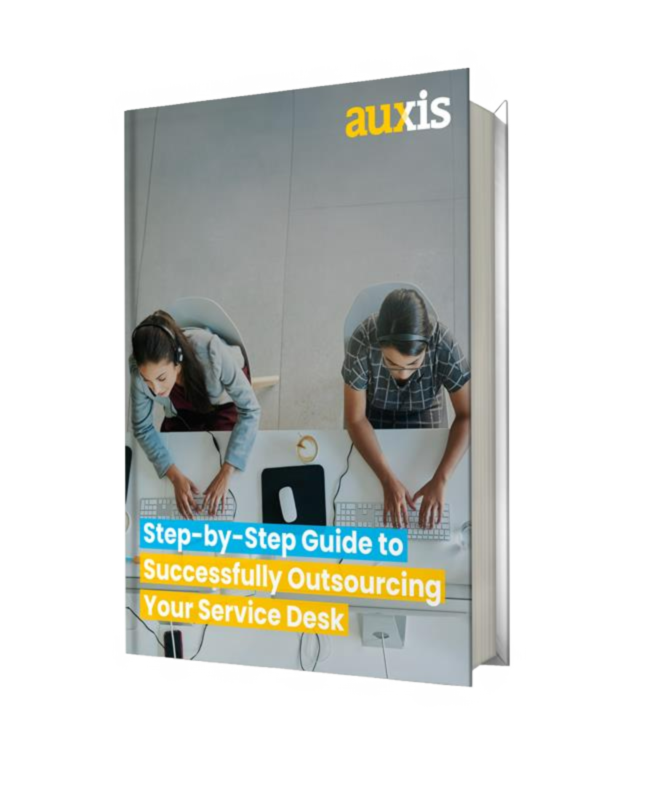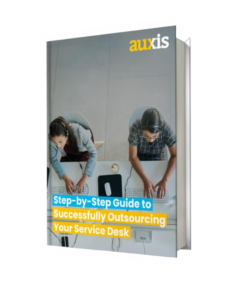In brief:
- Help desks across North America are struggling with an increasing volume of service tickets and persistent labor shortages.
- Businesses are looking to outsource help desk as a strategy for increasing cost efficiency and performance.
- Without the right strategy and tech like automation, help desk outsourcing can struggle to achieve the right balance of coverage, quality, and cost.
- The Auxis “Step-by-Step Guide to Successfully Outsourcing Your Help Desk” lays out 10 steps to outsource and maximize the value of your service desk.
Help desks across North America are battling dual challenges simultaneously: an explosion in the volume of service tickets and persistent labor shortages. IT service desks are busier than ever before as they cope with the widespread adoption of remote work, cloud technologies, and businesses accelerating digital transformation – all of which have led to a massive uptick in demand for tech support.
There is also a growing requirement for IT departments to become a strategic partner to the business in the face of rapid technological advancements, dynamic market shifts, and heightened competition. At the same time, organizations are also calling for a more user experience-focused service desk for higher employee productivity, engagement levels, and lower turnover.
Yet, without an effective solution to the help desk labor crisis, the IT department lacks the bandwidth to focus on strategic initiatives or improve user experiences.
The severe IT labor shortage has stretched IT departments thin, with Help Desk Tier 1 agent ranking among the hottest tech jobs this year, based on Robert Half’s 2024 Salary Guide. Even multi-billion-dollar businesses are no longer able to gather sufficient help desk resources in-house to provide 24/7 support, specialized expertise, and the latest technological innovations.
Unfortunately, service levels from understaffed help desks tend to be reactive, poor quality, and inconsistent, with high costs, inadequate service schedules, outdated knowledge bases, limited documentation and metrics, and calls routed to any available resource.
Increasingly, businesses are looking to outsource help desk as a strategy to ensure cost efficiency, let internal teams focus on core competencies, and deliver exceptional customer experiences. Outsourcing the help desk to a trusted third-party provider can instantly transform outdated help desks into High-Performance Service Desks, offering proactive support, speedy resolution, and modernized, high-quality technical support.
Fifty percent of IT organizations outsource help desk services, according to the 2023 IT Outsourcing Statistics Report by Computer Economics (Avasant Research). More than half (55%) of help desk processes are currently outsourced – a much higher percentage than other IT areas such as cloud management, application development, or IT security.
2025 Auxis Help Desk Report: A Step-by-Step Guide to Successfully Outsourcing your Service Desk

Build a high-performance service desk with the right strategy and support team
The Computer Economics report also found that outsourced help desk support ranks the lowest among IT functions for providing service experience at a level “same as” or “better” than what was achieved using in-house resources.
Without the right strategy and tech like automation, providers often struggle to deliver the right results – most often due to mismatched expectations, inadequately defined or aligned service-level agreements (SLAs), outsourced providers not fully understanding the client’s business or requirements, over-emphasis on cost reduction at the expense of quality support and customer satisfaction, and more.
Below we lay out some key steps to successfully outsource your organization’s help desk to ensure a modern, high-performance operation. For everything you need to know about these steps and more that can help you maximize the value of your outsourced help desk, download the Auxis “Step-by-Step Guide to Successfully Outsourcing Your Help Desk.”
1. Start with your end goal in mind
Too many outsourcing projects fall apart because organizations didn’t begin with an end goal in mind. Identifying your business drivers for outsourcing – and aligning your leadership team and outsourcing provider behind them – ensures your service desk delivers the value you need.
2. Clearly define service desk outsourcing scope and expectations
Most organizations run their help desks without a clear understanding of ticket volumes or the staffing levels, hours of operation, and technologies they need to provide quality support. Even when outsourcing, a cloudy vision of what your service desk should look like can make it difficult to achieve the right balance of coverage, quality, and cost.
Before outsourcing, invest time in thoroughly defining scope and expectations for your service desk. Determine what coverage hours make sense and be realistic about the provider’s role.
It’s also important to ensure your provider has the right tools to provide caller personalization as well as automation capabilities that make your service desk effective and efficient, and provide an elevated customer experience. Robust service-level agreements (SLAs) complemented by experience level agreements (XLAs) are another critical factor, creating a more holistic approach to performance measurement.
3. Define your location strategy based on your business footprint
How a vendor’s location fits into your business footprint matters to outsourcing success. Today, organizations rank physical proximity as the biggest factor when considering outsourced help desk operations, the Computer Economics report found, while low cost is the lowest-ranked priority.
Organizations are now more likely to choose a managed services provider within the same geographical region – even with lower cost options available in more distant locations – due to reduced operational challenges, easier management of data residency issues, and compatibility of language and time zone.
Latin America, over the last couple of decades, has demonstrated tremendous potential to support global operations and has emerged as a frontrunner for providing the right talent to staff U.S.-based operations with significant labor arbitrage. Top nearshoring hubs such as Costa Rica and Colombia combine quality tech talent with time zone proximity, English language and multilingual proficiency, as well as cultural compatibility.
4. Don’t fall for the myth of cost-per-ticket
The old adage “you get what you pay for” has never been truer than with outsourcing vendors. Help desk outsourcing services that look attractive on the surface like cheap Level 1 ticket servicing often hide ugly surprises, like poorly trained staff and frequent ticket escalations.
For a low cost-per-ticket model to work, organizations need high volumes, extremely standardized systems, and low service delivery expectations.
Every company has different technologies for service desks to support, making it impossible to create a one-size-fits-all model for ticket costs. If a vendor is offering very low cost-per-ticket, make sure you do your homework to understand what’s happening behind the scenes to make that pricing possible.
To learn six other critical steps – and receive more detailed insights on the four steps above – download the Auxis “Step-by-Step Guide to Successfully Outsourcing Your Help Desk.”
What’s included in our “Step-By-Step Guide to Successfully Outsourcing Your Help Desk?”
Download our Help Desk Outsourcing Guide to learn everything you need to know to maximize the value of your outsourced service desk. Our 10-step roadmap expands on the above steps and more, including:
- What to look for in your outsourcing partner
- Determining levels of support and escalations beyond Level 1, and whether a tiered or swarming model is ideal for your business requirements
- Automation capabilities that help you build a more proactive service desk
- Choosing the model that’s right for you – dedicated or shared resources?
- Defining the best location strategy based on your business footprint – nearshore, onshore, or offshore?
- Comparing apples to apples when quantifying your business case
- Establishing a robust process documentation and transition plan
- Learning to trust the process
Want to learn more about how outsourced help desk services can support your business priorities? Schedule a consultation with our help desk leaders today! Or visit our resource center to learn more help desk trends, strategies, and success stories.



